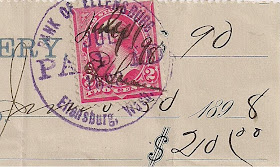Using contemporary newspaper reports and correspondence McMaster documents the failure of the government to adequately distribute tax stamps by July 1, 1898, the date the new tax laws took effect. He further documents the confusion that situation created for the public and district tax collectors, and how some citizens and firms lacking the proper tax stamps resorted to using postage stamps, postage due stamps, and even devalued revenue stamps from the Civil War era in "good faith" attempts to comply with the current law.
I've never seen usages of postage due stamps, or previously devalued revenue stamps used to pay Spanish-American War taxes and McMaster doesn't show any, but the use of postage stamps, the subject of his article, was widespread. Because of the problems with distributing the appropriate tax stamps the use of postage, at least for a while, was generally accepted and tolerated.
The practice, however, raised serious concern for the Department of Internal Revenue because when postage was used the revenue accrued to the Post Office and not to the Treasury. To forestall further loss of revenue, IR Commissioner Scott, with the approval of Treasury Secretary A.D. Gage, issued rules relative to the payment of the taxes that specifically forbid the use of “ordinary postage stamps”. The rules, pictured below, were part of Commissioner Decision 19935 dated August 22, 1898. By then the tax stamps were well distributed and widely available to anyone needing them.
Rulings relative to documentary and proprietary stamps
from Internal Revenue Decision 19935 dated August 22, 1898

July 1, 1898 First Day of Tax Period check
with ordinary 2-cent Bureau Issue postage stamp

 detail of Fuhrmann & Schmidt check showing stamp
detail of Fuhrmann & Schmidt check showing stampwith manuscript I. R. endorsement
Postage stamps manually endorsed I.R. by customers attempting to pay the internal revenue tax did not qualify under the Internal Revenue rules as the funds expended for such stamps still accrued to the Post Office and not the Treasury Department. Only postage stamps officially imprinted I.R. by the Bureau of Engraving and Printing and distributed by the Internal Revenue qualified as the funds used to purchase those stamps did accrue to the Treasury Department.
 September 9, 1898 Ross & Williams' Bank, Mansfield, PA check
September 9, 1898 Ross & Williams' Bank, Mansfield, PA checkwith two 1-cent Bureau Issue postage stamps used to pay the war tax
By September 9, 1898 revenue stamps were well distributed and as this use was after Commissioner Scott's published decision expressly forbiding the use of postage stamp, the bank should not have accepted them. Clearly though, the practice continued to be tolerated in many locales.
 January 18, 1899 Rutland (VT) Savings Bank check
January 18, 1899 Rutland (VT) Savings Bank check
with ordinary 2-cent Bureau Issue postage stamp
"Attach 2c Revenue Stamp as required by Law" endorsement
and a postage stamp with a manual "I. Revenue" endorsement
Tomarrow we'll examine some checks where the clerks processing them were less tolerant and required proper revenue stamps be affixed in addition to the illegally used postal issues.




No comments:
Post a Comment